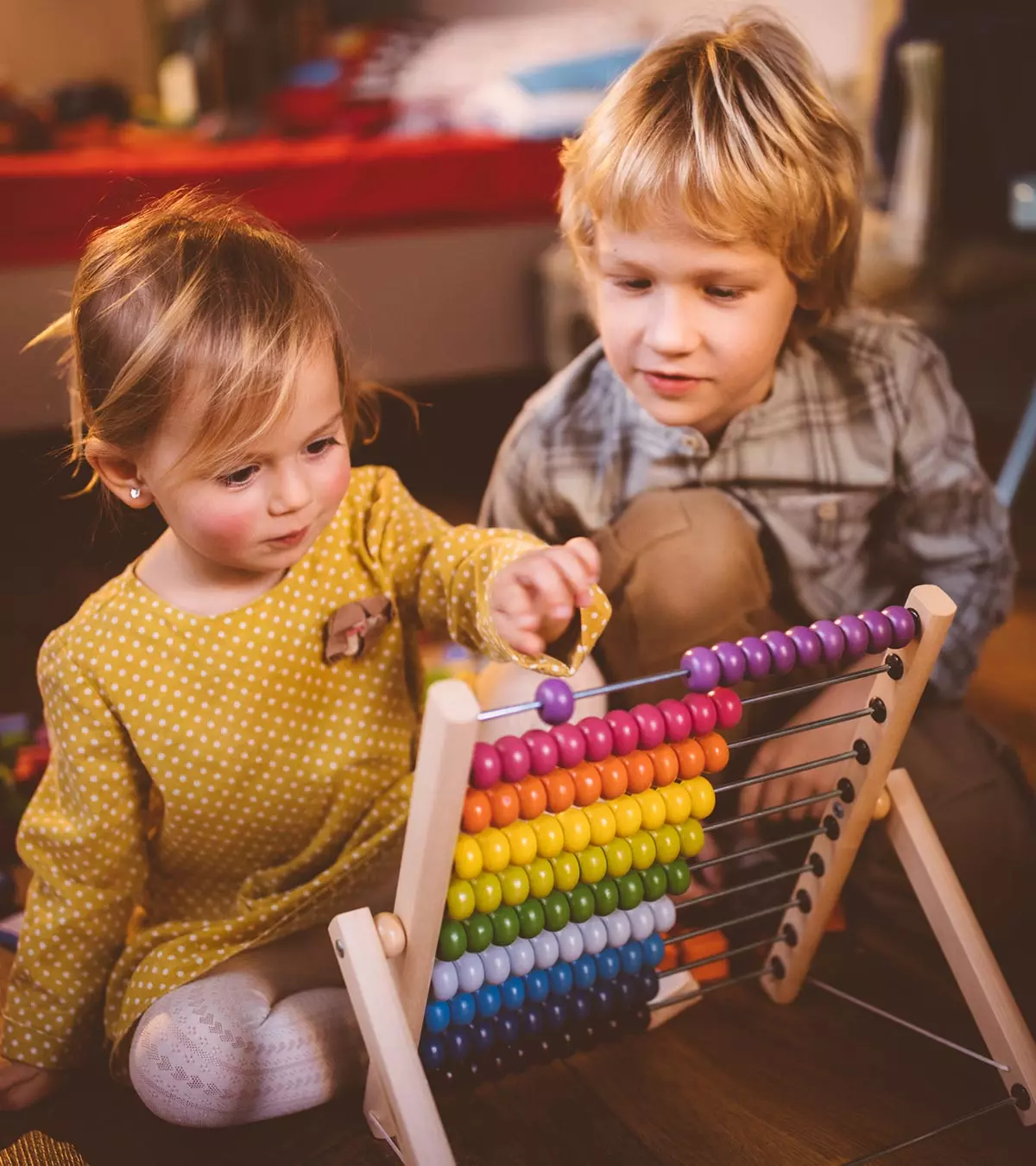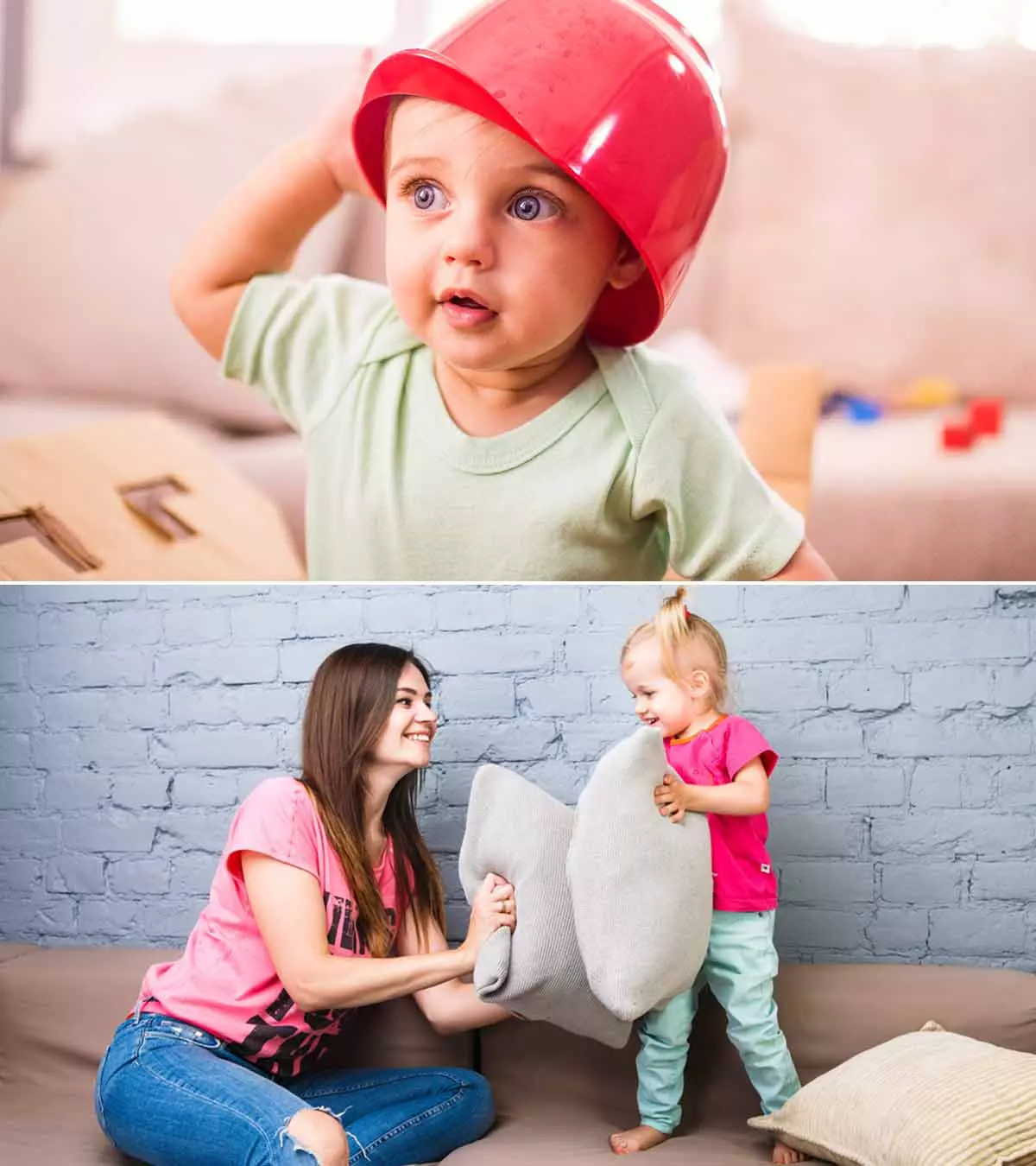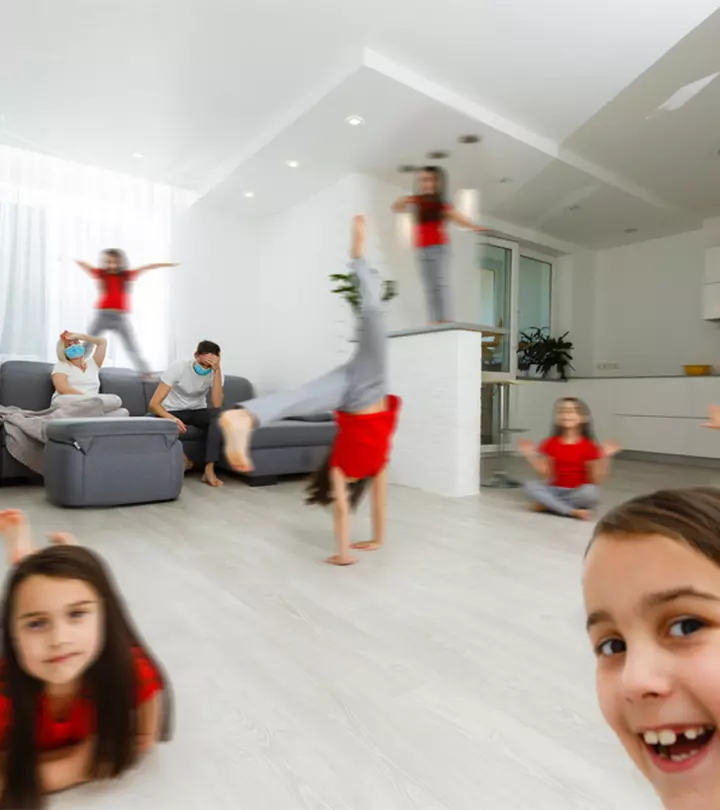
Image: Shutterstock
Children with an anxiety disorder may experience irrational nervousness and fear, affecting their daily functioning. Thus, anxiety activities for kids can help them cope with the situation and go about with their routines.

Anxiety is a feeling of extreme nervousness or uneasiness about a situation or outcome, and all children experience anxiety at some point. However, some may fail to overcome the fears, anxiety, or worries common in early childhood such as socialization. Therefore, encouraging children with anxiety to practice good habits and engage in activities is vital to help them overcome their anxiety (1) (2).
Read this post as we have put together a list of activities you can perform with your child to promote feelings of calmness and prevent anxiety.
Key Pointers
- Anxiety in children might impact their routines and normal functioning.
- Introduce calming games and activities such as bubble blowing or painting to relax your child.
- Blowing bubbles, painting, and more could help your child cope with the stress and other adverse effects of anxiety.
16 Activities For Children With Anxiety
1. Mind jars
The calming glitter jar, also called the mind jar, is a fun craft project that you can do with your child. It serves as an excellent example of mindfulness activities and games for kids, helping them focus and relax. It is a tried-and-true mindfulness project known to aid relaxation (3). The goal is for your child to use this jar on their own when they experience anxiety. The calming jar activity helps children relax, focus, and realize that paying attention to their senses can lessen their anxiety.
Directions to make a mind jar: Add glitter glue in a glass jar filled with warm water and mix well. Remember, the warmer the water, the easier it is to dissolve the glitter without clumps. Add food coloring and sequins to make the mixture more vibrant and sparkling. Fill the jar with warm water up to the brim. Finally, make sure the caps of the jars are glued on properly to avoid spills.
 Quick tip
Quick tip2. Relaxation stones

Create small and smooth relaxation stones with oven-baked clay. You may add a thumb-shaped indentation to each to help your child relax while rubbing their fingers on it.
You can also collect stones of different shapes and sizes, paint them, and write short, positive messages or quotes on them.
3. Blowing Bubbles
Activities that involve deep breathing have a calming effect on the nervous system and the brain (4). For example, blowing bubbles requires deep breathing techniques and is thus helpful for children with anxiety and tension.
Make a mixture of soap and water and store it in a container. Then, let your child blow as many bubbles as they can using a bubble blower. You can also make this activity more interesting by making your child blow bubbles over their head while lying on the ground on their back. Let them observe the bubbles as they gradually reach the ground.
4. Painting
Research has proven that activities promoting creativity, such as painting or other art forms, benefit children with anxiety (5). Creating art also helps children direct all their attention and focus in the present moment. Younger children may enjoy finger painting.
5. Pretend to be a superhero
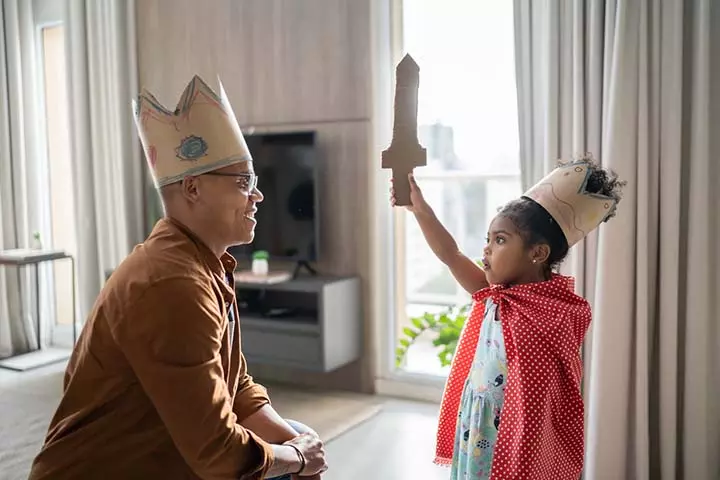
Children are highly influenced by their imagination of superheroes and the powers they possess. Let your child imagine themselves to be a superhero. Ask them about the superpowers and strengths they wish to possess, and try some of these amazing superhero activities for kids to help them relax or keep them engaged. This activity may also encourage positive self-talk in children and strengthen their mental strength.
6. Anxiety companion
Give your children a toy or pet for hugs and to help them face their worries and anxieties. A worry or anxiety companion is an object or pet your child can talk to and share their feelings with when anxious. Encourage them to talk about what might be bothering them, why it is bothering them, and how they want to feel. The friendly and comforting companion can help put your child’s mind at ease (6).
7. Instant comfort or anxiety coping boxes

Make a box for your child containing slips of paper with positive messages or quotes that can be an instant source of motivation when they feel anxious and you are not around them to comfort them. These messages can be written either by you or your child.
8. Collage
Give your children magazines containing colorful, bright pictures and ask them to make a collage with the pictures they find calming. Making a collage can help them forget about their worries and release stress. It does not require complex artistic skills, and your child can express themselves freely.
9. Stress balls
Stress balls have always been a go-to remedy for tackling stress and anxiety. You can either make DIY stress balls at home with your child or purchase them from the market. Squeezing a stress ball stimulates the nerves and muscles and improves the overall nervous system, thus reducing cortisol, the main stress hormone (7).
 Quick tip
Quick tip10. Bibliotherapy
Bibliotherapy, also referred to as book therapy or therapeutic storytelling, is the process of reading a story or certain parts of a story to your child with the purpose of healing or making them feel calm (8). Read a storybook to your child and help them relate to the characters in the story.
11. Journaling
Maintaining a journal allows your child to find an outlet for all the emotions and feelings they may be unable to express. So, give your child a journal and let them write whatever they feel. This simple act of writing will help them validate their feelings such as fears and gratitude, understand the stressors, and control or manage those stressors (9).
12. 5-4-3-2-1 sensory activity

This is a simple yet effective activity you can introduce to your child as it is known to help regain their calm nature and composure when moments of anxiety hit them.
Ask your child to look around their surroundings and search for five things they can touch, four things they can see, three things they can hear, two things they can smell, and one thing they can taste. This will help them distract their minds from the anxiety and also make them feel better. Besides, the activity is also perfect for teaching young children about the five senses.
13. Happy brain, worry brain
This activity will help you understand your child’s weaknesses and strengths and develop their coping skills.
Take two pieces of paper. Label one of them as ’Happy Brain’ and the other as ’Worry Brain.’ Now let your child fill them in with the thoughts or feelings that might fit into each category such as humor, fear, excitement, etc.
14. Worry escape corner or room
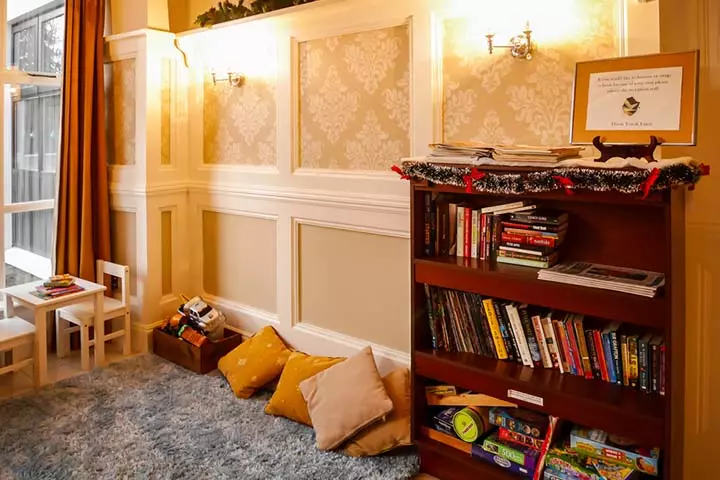
Identify a cozy corner or room in your house where your child usually likes to sit or play. Decorate the area with a cozy blanket, cushions, ambient lights, keep your child’s favorite things around it, and play their favorite music. This will act as a safe space for your child when they feel anxious.
15. Calm down toolbox
Put numerous things in a calm-down toolbox for your child and personalize it according to their needs and requirements. For example, you can put relaxation stones, a stress ball, a journal, and a few other items to help your child when they have anxiety.
16. Yoga
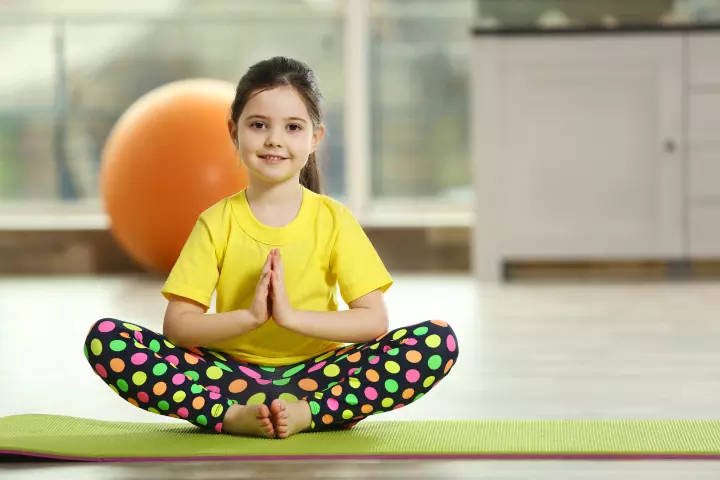
Yoga is an effective tool for children with anxiety, offering a blend of physical exercise, deep breathing, and mental well-being. It helps unify the body, mind, and spirit, leading to a calmer state of being. Yoga’s diaphragmatic breathing and balance-focused poses, like the child’s and tree poses, are particularly beneficial for anxious children. These practices encourage mindfulness, concentration, and a sense of community in a non-judgmental environment, enhancing self-esteem and confidence. Regular yoga practice has been shown to alleviate anxiety, stress, and even physical ailments like back pain. Making yoga sessions fun and engaging for children is important, using imaginative pose names and storytelling to maintain their interest and commitment. Yoga not only helps in managing anxiety but also improves overall mood and functioning in children.
Frequently Asked Questions
1. How can I encourage my child to take part in anxiety-calming activities?
Start by making a routine with a set time for conducting anxiety-relief exercises. Create a comfortable environment where children can express their feelings about participating in the activities and share the emotions they experience during them. Additionally, participate in the exercises together to help ease their fears and strengthen your connection with them.
2. Does play therapy help anxiety?
Yes, play therapy can help children cope with their anxiety. The ability to master or solve a game or activity can induce a sense of confidence and satisfaction and increase their self-esteem while aiding in their sensorimotor development (10).
3. How do puzzles help manage anxiety in kids?
The satisfaction or sense of accomplishment from solving puzzles is believed to release a feel-good dopamine hormone. Thus puzzles help relax and reduce anxiety (11).
4. How do anxiety activities for kids differ from traditional relaxation techniques?
Anxiety activities and traditional relaxation techniques differ in terms of approach and purpose. Traditional relaxation techniques, such as deep breathing and meditation, focus on soothing the mind and body through passive engagement. Anxiety activities, in contrast, focus more on managing and reducing anxiety symptoms through active engagement. Similarly, anxiety activities utilize distraction to divert attention away from anxious thoughts and feelings. Traditional relaxation techniques, on the other hand, emphasize mindfulness, which involves focusing on the present moment and accepting one’s thoughts and emotions without judgment.
5. What age group are anxiety activities for kids suitable for?
Anxiety activities for children are suitable for children across ages. The specific activities and techniques can be tailored to meet each child’s developmental needs and abilities, considering their maturity level and interests.
6. Can anxiety activities for kids be used in conjunction with therapy or medication?
Yes, anxiety activities for children can be used along with therapy and medication. These activities can help cope with their anxiety. However, it’s worth noting that they are not a substitute for treatment and medical interventions.
7. Can anxiety activities for kids be incorporated into daily routines and schedules?
Yes, anxiety activities for kids can be incorporated into their daily routine to help consistent management of their anxious thoughts and feelings. In addition, they can help create a sense of comfort, familiarity, and support in managing anxiety. You can designate a specific time during the morning or bedtime to engage in these activities. Children can also take several short breaks throughout the day to indulge in these activities.
8. What is the 3 3 3 rule for children with anxiety?
The ‘3 3 3 rule’ is a simple mindfulness technique that helps shift focus away from anxious thoughts and bring attention to the present moment. This technique involves – naming three things they see and three sounds they hear in their immediate environment. It also involves moving three different body parts, which helps them focus on sensations in their body.
9. What triggers anxiety for kids?
Academic pressure, separation from a parent/caregiver, social situations, such as meeting new people, and specific phobias, such as fear of heights, are among several potential reasons that can trigger anxiety in children.
Anxiety can affect all children at some point, and it can interfere with their ability to perform regular chores. To help children overcome their anxiety, teach them how to manage and live with it rather than remove the situations that create it by indulging in fun-filled activities that bring smiles and laughter. These anxiety activities for kids include craft ideas to engage their minds, positive phrases and quotes to encourage them, meditation exercise, or book therapy to calm them. Help your child by counseling them into choosing the activities that will benefit them the most to feel comfortable and calm their anxious minds.
Infographic: Calming Activities For Children With Anxiety
If your child is diagnosed with anxiety issues, they may require additional love and support to cope with everyday challenges. Apart from talking to them and engaging them in breathing and relaxation techniques, you may try the activities mentioned in this infographic to help them cope with their anxiety better.
Some thing wrong with infographic shortcode. please verify shortcode syntax
Illustration: Calming Games And Activities For Children With Anxiety

Image: Stable Diffusion/MomJunction Design Team
Check out this video to learn how physical activity can help children reduce anxiety and depression. It’s an easy and fun way to boost mood and improve mental health.
References
- Anxiety.
https://www.apa.org/topics/anxiety - Anxiety and Depression in Children.
https://www.cdc.gov/children-mental-health/about/about-anxiety-and-depression-in-children.html - Make Your Own Calming Mind Jars For Kids.
https://sclhealth.org/blog/2019/08/mind-jars/ - Relaxation techniques: Breath control helps quell errant stress response.
https://www.health.harvard.edu/mind-and-mood/relaxation-techniques-breath-control-helps-quell-errant-stress-response - The healing power of art.
https://www.health.harvard.edu/mental-health/the-healing-power-of-art - The Power of Pets.
https://newsinhealth.nih.gov/2018/02/power-pets - The Health Benefits of Stress Balls.
https://www.brownhillsurgery.co.uk/the-health-benefits-of-stress-balls/ - Krystal M.Lewis et al.; (2015); Treating nighttime fears in young children with bibliotherapy: Evaluating anxiety symptoms and monitoring behavior change.
https://www.sciencedirect.com/science/article/abs/pii/S0887618514001790 - Journaling for Mental Health.
https://www.urmc.rochester.edu/encyclopedia/content.aspx?ContentID=4552&ContentTypeID=1 - Wa Ode Nursanaa and Intan Novantin Citra Ady; (2025); Play Therapy for Children with Anxiety Disorders.
https://www.researchgate.net/publication/339186482_Play_Therapy_for_Children_with_Anxiety_Disorders - Stress relief Through Puzzles.
https://www.med.unc.edu/phyrehab/wp-content/uploads/sites/549/2025/04/4.3.2025-Wellness-v2.pdf
Community Experiences
Join the conversation and become a part of our nurturing community! Share your stories, experiences, and insights to connect with fellow parents.
Read full bio of Dr. Jessica Madden
Read full bio of Sanjana Bhattacharjee
Read full bio of Harshita Makvana
Read full bio of Apoorva K











